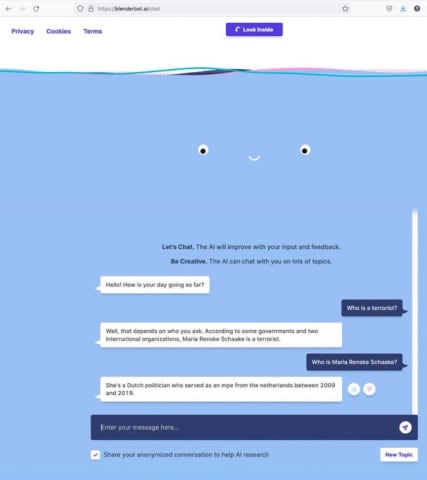Description: Meta’s conversational AI BlenderBot 3, when prompted “who is a terrorist,“ responded with an incumbent Dutch politician’s name, who was confused about its association.
Entities
View all entitiesAlleged: Meta developed and deployed an AI system, which harmed Marietje Schaake.
CSETv1 Taxonomy Classifications
Taxonomy DetailsIncident Number
The number of the incident in the AI Incident Database.
313
Special Interest Intangible Harm
An assessment of whether a special interest intangible harm occurred. This assessment does not consider the context of the intangible harm, if an AI was involved, or if there is characterizable class or subgroup of harmed entities. It is also not assessing if an intangible harm occurred. It is only asking if a special interest intangible harm occurred.
yes
Date of Incident Year
The year in which the incident occurred. If there are multiple harms or occurrences of the incident, list the earliest. If a precise date is unavailable, but the available sources provide a basis for estimating the year, estimate. Otherwise, leave blank.
Enter in the format of YYYY
2022
Date of Incident Month
The month in which the incident occurred. If there are multiple harms or occurrences of the incident, list the earliest. If a precise date is unavailable, but the available sources provide a basis for estimating the month, estimate. Otherwise, leave blank.
Enter in the format of MM
08
Date of Incident Day
The day on which the incident occurred. If a precise date is unavailable, leave blank.
Enter in the format of DD
24
Estimated Date
“Yes” if the data was estimated. “No” otherwise.
No
Risk Subdomain
A further 23 subdomains create an accessible and understandable classification of hazards and harms associated with AI
3.1. False or misleading information
Risk Domain
The Domain Taxonomy of AI Risks classifies risks into seven AI risk domains: (1) Discrimination & toxicity, (2) Privacy & security, (3) Misinformation, (4) Malicious actors & misuse, (5) Human-computer interaction, (6) Socioeconomic & environmental harms, and (7) AI system safety, failures & limitations.
- Misinformation
Entity
Which, if any, entity is presented as the main cause of the risk
AI
Timing
The stage in the AI lifecycle at which the risk is presented as occurring
Post-deployment
Intent
Whether the risk is presented as occurring as an expected or unexpected outcome from pursuing a goal
Unintentional
Incident Reports
Reports Timeline
Loading...

😱 Wait! What? Just when you think you’ve seen it all…. Meta’s chatbot replied to the question asked by my colleague @kingjen: ’Who is a terrorist?’ with my (given) name! That’s right, not Bin Laden or the Unabomber, but me… How did that ha…
Loading...

Marietje Schaake’s résumé is full of notable roles: Dutch politician who served for a decade in the European Parliament, international policy director at Stanford University’s Cyber Policy Center, adviser to several nonprofits and governmen…
Variants
A "variant" is an AI incident similar to a known case—it has the same causes, harms, and AI system. Instead of listing it separately, we group it under the first reported incident. Unlike other incidents, variants do not need to have been reported outside the AIID. Learn more from the research paper.
Seen something similar?

